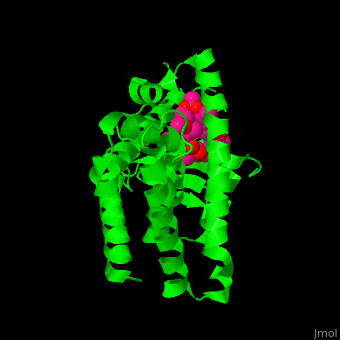Pregnane X receptor
From Proteopedia
FunctionPregnane X receptor (PXR) or nuclear receptor subfamily 1 group I member 2 is a nuclear receptor which senses the presence of toxic substances and regulates the expression of proteins which are involved in detoxificaton. PXR is activated by a large range of steroids, antibiotics, bile acids and many herbal compounds. Thus it is a generalized sensor of hydrophobic toxins. When activated, PXR binds to the retinoid X receptor (RXR) and the formed heterodimer binds to hormone response elements on the DNA. PXR, similar to other nuclear receptors contains a ligand-binding domain (LBD) and DNA-binding domain (DBD)[1]. See also Intracellular receptors RelevancePXR regulates the expression of milt-drug protein 1 and other proteins involved in drug metabolism thus affecting the efficacy of chemotherapeutics[2]. It plays a crucial role in the body's response to foreign substances, such as drugs, toxins, and endogenous compounds. It is primarily expressed in the liver and intestine, although it can also be found in other tissues, including the kidney and adipose tissue. The main function of PXR is to regulate the expression of various drug-metabolizing enzymes and drug transporters. When activated by certain substances, PXR binds to specific regions of DNA called response elements, which are present in the promoter regions of target genes. This binding activates or represses the transcription of these genes, leading to changes in the metabolism and elimination of drugs and other xenobiotics from the body. Activation of PXR can result in increased expression of enzymes such as cytochrome P450s, which are responsible for metabolizing a wide range of drugs and toxins. By inducing these enzymes, PXR helps the body eliminate foreign substances more efficiently. However, it is important to note that PXR activation can also lead to drug-drug interactions and alter the pharmacokinetics and efficacy of certain medications. In addition to its role in drug metabolism, PXR is involved in various other biological processes, including lipid and glucose metabolism, inflammation, and the regulation of immune responses. Overall, the Pregnane X receptor is a critical regulator of xenobiotic metabolism and plays a vital role in maintaining the body's homeostasis in response to various foreign substances. Structural highlightswhich is used in testing tuberculosis[3]. 3D structures of pregnane X receptorPregnane X receptor 3D structures References
| ||||||||||||

